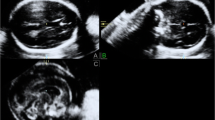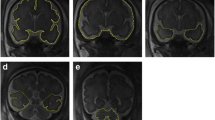Abstract
Purpose
To obtain three-dimensional ultrasonic (3D US) structural details and biometrics of the fetal cerebellar vermis and evaluate the value of developmental and malformation identification.
Methods
The 3D US minute structure of the fetal cerebellar vermis in mid-sagittal view was detected in normal fetuses (n = 438; 16–41 weeks). Biometric sizes were measured to establish the stage-specific norms and reproducibility analysis. Additionally, 28 fetuses with suspected abnormal posterior fossa contents were assessed to analyze the clinical value.
Results
The minute structure of normal fetuses, including cerebellar vermis contours and the fastigial recess of the fourth ventricle, were visible around Week 19. The main lobules and fissures were apparent around Week 22, and all nine lobules, fissures, and the fourth ventricle were clearly displayed by Week 28. Cerebellar vermis biometric sizes (anterior–posterior length, cranio-caudal length, circumference, and surface area (SA)) grew in a linear fashion with high reliability, especially SA measurements (for intraclass, ICC 0.989, 95% CI (0.980–0.994); for interclass, ICC 0.992, 95% CI (0.984–0.996)). On the middle sagittal section of 3D US, the SA reduced at least 50% in the Dandy–Walker group with no recognizable cerebellar vermis structures showing. The SA in vermian hypoplasia malformation reduced during \(\bar{x} - 2{\text{SD}}\) to 50% with the primary/secondary fissures absent or partly absent and arborization of the lobules reduced. That would be an important diagnosis and antidiastole clue. Combined with minute structural observation, sonographic diagnoses were accurate in 88% of cases.
Conclusion
Minute structures obtained by 3D US were clinically useful in the evaluation of cerebellar vermis development and cerebellar vermis malformations.





Similar content being viewed by others
References
Dudek K, Nowakowska-Kotas M, Kędzia A. Mathematical models of human cerebellar development in the fetal period. J Anat. 2018;232:596–603.
Katorza E, Bertucci E, Perlman S, et al. Development of the fetal vermis: new biometry reference data and comparison of 3 diagnostic modalities-3d ultrasound, 2d ultrasound, and mr imaging. AJNR Am J Neuroradiol. 2016;37:1359–66.
Wüest A, Surbek D, Wiest R, et al. Enlarged posterior fossa on prenatal imaging: differential diagnosis, associated anomalies and postnatal outcome. Acta Obstet Gynecol Scand. 2017;96:837–43.
D’Antonio F, Khalil A, Garel C, et al. Systematic review and meta-analysis of isolated posterior fossa malformations on prenatal ultrasound imaging (part 1): nomenclature, diagnostic accuracy and associated anomalies. Ultrasound Obstet Gynecol. 2016;47:690–7.
Kapur RP, Mahony BS, Finch L, et al. Normal and abnormal anatomy of the cerebellar vermis in midgestational human fetuses. Birth Defects Res A Clin Mol Teratol. 2009;85:700–9.
Dovjak GO, Brugger PC, Gruber GM, et al. Prenatal assessment of cerebellar vermian lobulation: fetal MRI with 3 Tesla post-mortem correlation. Ultrasound Obstet Gynecol. 2017. https://doi.org/10.1002/uog.18826.
Zhao D, Cai A, Zhang J, et al. Measurement of normal fetal cerebellar vermis at 24–32 weeks of gestation by transabdominal ultrasound and magnetic resonance imaging: a prospective comparative study. Eur J Radiol. 2018;100:30–5.
Chapman T, Mahalingam S, Ishak GE, et al. Diagnostic imaging of posterior fossa anomalies in the fetus and neonate: part 2, posterior fossa disorders. Clin Imaging. 2015;39:167–75.
Rizzo G, Pietrolucci ME, Mammarella S, et al. Assessment of cerebellar vermis biometry at 18–32 weeks of gestation by three-dimensional ultrasound examination. J Matern Fetal Neonatal Med. 2012;25:519–22.
You JH, Lv GR, Liu XL, et al. Reference ranges of fetal spleen biometric parameters and volume assessed by three-dimensional ultrasound and their applicability in spleen malformations. Prenat Diagn. 2014;34:1189–97.
Frisova V, Srutova M, Hyett J. 3-D volume assessment of the corpus callosum and cerebellar vermis using various volume acquisition and post-processing protocols. Fetal Diagn Ther. 2018;43:199–207.
Rizzo G, Abuhamad AZ, Benacerraf BR, et al. Collaborative study on 3-dimensional sonography for the prenatal diagnosis of central nervous system defects. J Ultrasound Med. 2011;30:1003–8.
Chapman T, Mahalingam S, Ishak GE, et al. Diagnostic imaging of posterior fossa anomalies in the fetus and neonate: part 1, normal anatomy and classification of anomalies. Clin Imaging. 2015;39:1–8.
Zalel Y, Yagel S, Achiron R, et al. Three-dimensional ultrasonography of the fetal vermis at 18 to 26 weeks’ gestation: time of appearance of the primary fissure. J Ultrasound Med. 2009;28:1–8.
Malinger G, Ginath S, Lerman-Sagie T, et al. The fetal cerebellar vermis: normal development as shown by transvaginal ultrasound. Prenat Diagn. 2001;21:687–92.
Cignini P, Giorlandino M, Brutti P. Reference charts for fetal cerebellar vermis height: a prospective cross-sectional study of 10605 fetuses. PLoS One. 2016;11:e0147528.
Spinelli M, Sica C, Meglio LD, et al. Fetal cerebellar vermis circumference measured by 2-dimensional ultrasound scan: reference range, feasibility and reproducibility. Ultrasound Int Open. 2016;2:E124–8.
Xie Hongning CD, Zhu Yunxiao LL. Study on the development of fetal cerebellar vermis with the third plane image of three-dimensional ultrasonography. Chin J Pract Gynecol Obstet. 2006;22:32–4.
Bromley B, Nadel AS, Pauker S, et al. Closure of the cerebellar vermis: evaluation with second trimester US. Radiology. 1994;193:761–3.
Babcook CJ, Chong BW, Salamat MS, et al. Sonographic anatomy of the developing cerebellum: normal embryology can resemble pathology. AJR Am J Roentgenol. 1996;166:427–33.
Zalel Y, Gilboa Y, Gabis L, et al. Rotation of the vermis as a cause of enlarged cisterna magna on prenatal imaging. Ultrasound Obstet Gynecol. 2006;27:490–3.
Pinto J, Paladini D, Severino M, Morana G, Pais R, Martinetti C, Rossi A. Delayed rotation of the cerebellar vermis: a pitfall in early second-trimester fetal magnetic resonance imaging. Ultrasound Obstet Gynecol. 2016;48:121–4.
Paladini D, Volpe P. Posterior fossa and vermian morphometry in the characterization of fetal cerebellar abnormalities: a prospective three-dimensional ultrasound study. Ultrasound Obstet Gynecol. 2006;27:482–9.
Martins WP, Nastri CO. Interpreting reproducibility results for ultrasound measurements. Ultrasound Obstet Gynecol. 2014;43:479–80.
Acknowledgements
We thank all the project participants for their contributions and Medjaden Bioscience Limited for assisting in the preparation of this manuscript.
Funding
This study was supported by Grants from the National Natural Science Foundation of China (no. 81271587) and the Key Program of Scientific Research of Fujian Medical University, P. R. China (no. 09ZD015) and the Natural Science Foundation of Fujian Province (no. 2015D015 & no. 2015J01363).
Author information
Authors and Affiliations
Corresponding author
Ethics declarations
Informed consent
Informed consent was obtained from patients and healthy controls in this study, and the study was approved by the Ethics Committee of the School of Medicine, Xiamen University.
Conflict of interest
The authors declare that they have no conflicts of interest.
About this article
Cite this article
Xie, Jx., You, Jh., Chen, Xk. et al. Three-dimensional sonographic minute structure analysis of fetal cerebellar vermis development and malformations: utilizing volume contrast imaging. J Med Ultrasonics 46, 113–122 (2019). https://doi.org/10.1007/s10396-018-0906-x
Received:
Accepted:
Published:
Issue Date:
DOI: https://doi.org/10.1007/s10396-018-0906-x




